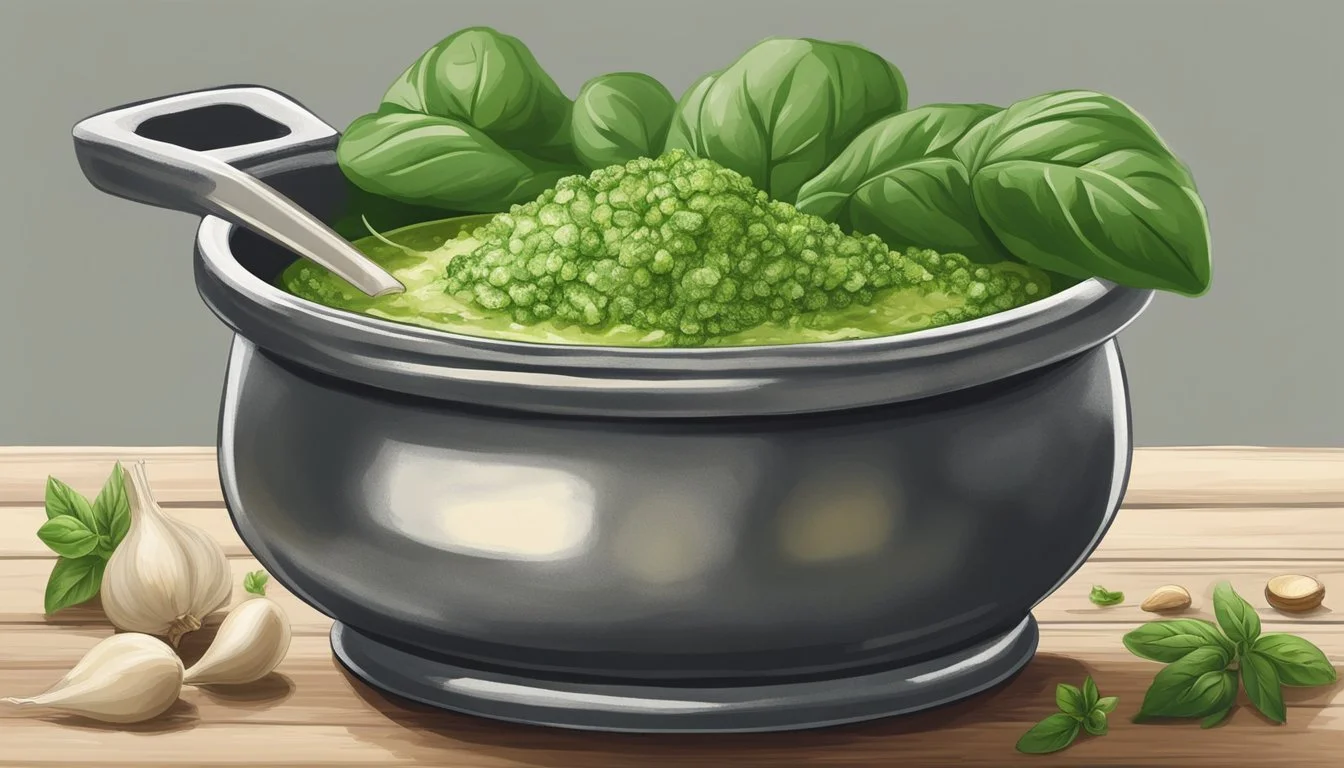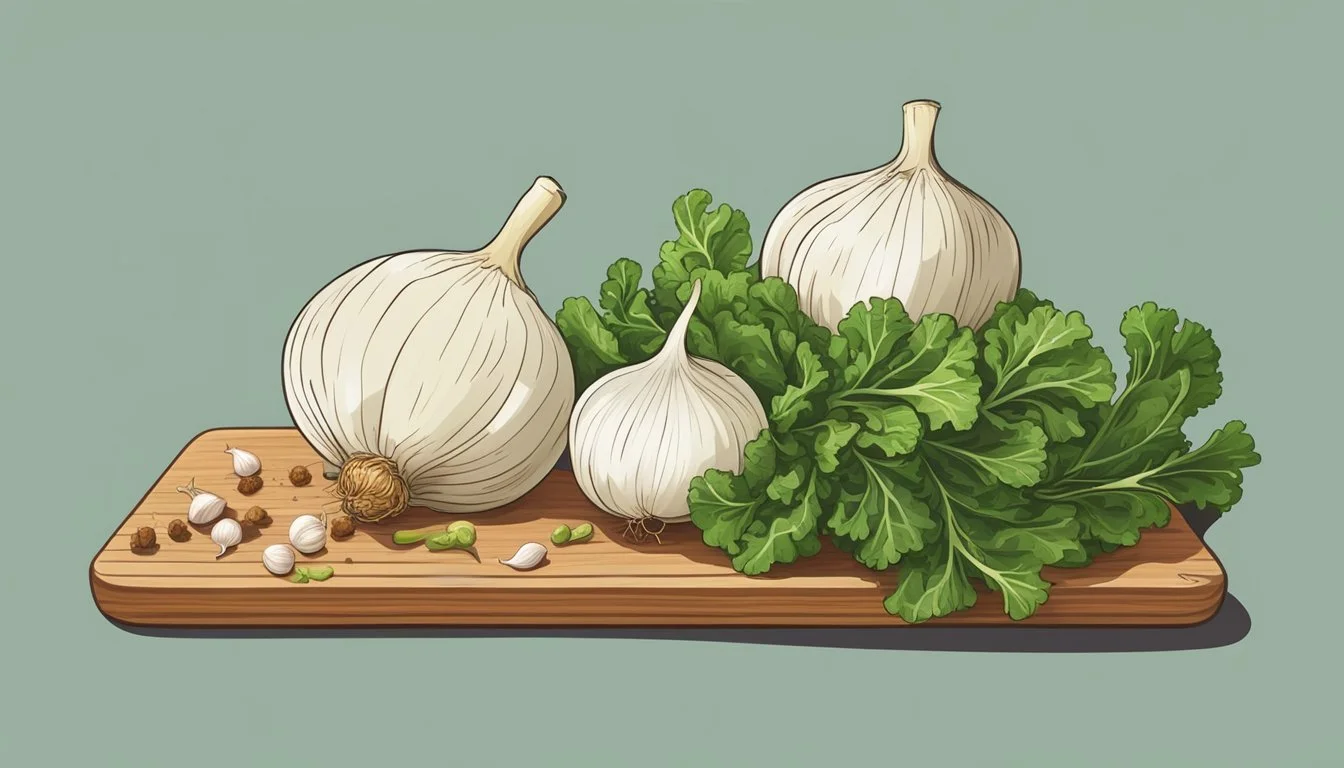Turnip Green Pesto
Elevating the Classic with a Spicy, Bitter Edge
Turnip green pesto offers a twist on the traditional basil-based condiment by incorporating the slightly spicy and bitter flavors of turnip greens. This variation not only adds a unique taste profile to dishes but also utilizes a part of the turnip that is often discarded. Rich in nutrients, turnip greens make the pesto a healthier option, bringing both flavor and benefits to the table.
The process of creating turnip green pesto involves blanching the greens briefly to reduce bitterness, then blending them with nuts, cheese, and seasoning to form a versatile paste. This pesto can be used in the same way as classic pesto, such as on pasta, bruschetta, or as a vibrant addition to sandwiches and wraps, providing an earthy depth to a plethora of culinary creations.
While the use of turnip greens in pesto may be considered unconventional, it is a sustainable choice that maximizes the use of available ingredients. This pesto variant adheres to the principles of a waste-free kitchen by transforming what might be considered scraps into a gourmet component, showing that flavor and resourcefulness can go hand in hand.
The Basics of Pesto
Pesto is a sauce that hinges on its simplicity and versatility, traditionally made with basil, oil, and other fresh ingredients. This section explores its definition and how turnip greens can play a pivotal role in this classic sauce.
Defining Pesto
Pesto, at its core, is an Italian sauce that marries fresh herbs, predominantly basil, with garlic, nuts, Parmesan cheese, and olive oil. The ingredients are typically blended together to create a versatile paste that is rich in flavor and has a luxurious texture.
Traditional Pesto Ingredient Role in Pesto Basil Primary green providing a fresh, aromatic flavor Olive Oil Acts as a binder, bringing together the flavors and adding richness Nuts (Pine or Walnuts) Add texture and a nutty depth Garlic Offers a sharp, pungent kick Parmesan Cheese Contributes a savory, slightly salty note
Turnip Greens as a Pesto Star
Turnip greens are a less conventional choice for pesto, but they bring a unique spicy and slightly bitter edge compared to the sweet notes of basil. When choosing turnip greens as the primary green, one transforms the sauce into a robust and hearty condiment. To best integrate these greens into pesto, they should be prepped properly: washed, and if necessary, blanched to soften their bite. The spicy-bitter taste of the turnip greens pairs well with milder oils and can be balanced with roasted nuts like walnuts, adding a textural contrast to the smoothness of the processed greens.
Ingredient Spotlight
In crafting Turnip Green Pesto, the selection of key ingredients is paramount to achieve the desired balance of flavors and textures. This section will guide you through each essential component, their roles, and alternatives where applicable.
Key Ingredients for Turnip Green Pesto
Turnip greens, the star of the pesto, introduce a spicy and slightly bitter profile unlike traditional basil. Garlic adds a pungent kick, while nuts such as pine nuts or walnuts lend a crunchy texture and rich flavor. When selecting cheese, Parmesan is the classic choice, but can be substituted with vegetarian Parmesan for those adhering to a vegetarian diet.
Turnip Greens: Spicy and bitter notes.
Nuts: Pine nuts or walnuts for texture and richness.
Garlic: Aromatic intensity.
Cheese: Parmesan or vegetarian alternatives for a savory touch.
Understanding the Role of Oil in Pesto
Extra virgin olive oil is traditionally used for its vibrant taste and health benefits. It acts as a binder, combining all ingredients into a cohesive sauce. The quality of the oil impacts the final flavor; thus, a high-quality extra virgin olive oil is preferred for both taste and consistency.
Extra Virgin Olive Oil: Preferred for superior taste and binding qualities.
Cheese Varieties and Vegan Alternatives
Cheese imparts a sharp and savory element to pesto. Parmesan cheese, with its tang and saltiness, is the usual choice. For a vegan option, nutritional yeast can replace cheese, offering a similar umami profile without dairy.
Parmesan Cheese: Traditional, tangy, salty.
Nutritional Yeast: Dairy-free, umami-rich substitute.
Seasonings and Flavor Enhancers
Seasonings such as kosher salt and black pepper are crucial in pesto. They serve to amplify the inherent flavors of the greens and garlic. A squeeze of lemon juice adds brightness and can help balance the bitterness of the turnip greens with its citrus accent.
Kosher Salt: Enhances flavor, less intense than table salt.
Black Pepper: Adds depth and warmth.
Lemon Juice: Brightens and balances flavors.
Preparation Techniques
In crafting Turnip Green Pesto, technique is as pivotal as the ingredients. Utilizing the correct tools, achieving the ideal consistency, and ensuring the pesto remains fresh are critical components to creating this flavorful condiment.
Choosing the Right Equipment
The cornerstone of making pesto is a food processor or a blender, both of which can effectively combine ingredients into the desired paste. A food processor is preferred for its ability to create a uniform texture, but a blender can be a suitable alternative if one operates it with care to avoid an overly liquefied result.
Creating the Perfect Texture
The texture of Turnip Green Pesto is paramount, distinguishing a good pesto from a great one. Start by:
Blanching the greens for just a few minutes to mitigate bitterness.
Ensuring greens are thoroughly dry, either by patting them with paper towels or letting them air-dry, to prevent a watery pesto.
Pulsing the turnip greens, nuts, cheese, and garlic in the food processor to a coarse mix before slowly streaming in the olive oil until the mixture forms a coherent paste.
Storing for Freshness
Longevity of Turnip Green Pesto hinges on proper storage. To retain freshness:
Transfer pesto into an airtight container.
Lay a piece of plastic wrap directly on the surface of the pesto to prevent oxidation.
Refrigerate for up to a week or freeze for extended use.
Recipes and Applications
Turnip green pesto adds a peppery sharpness to traditional pesto, giving it a unique flavor profile. This versatile sauce can be used in a variety of dishes, marrying well with vegetables, bread, and pasta.
Classic Turnip Green Pesto Recipe
For a classic turnip green pesto:
Ingredients
Turnip greens, cleaned and dried
Walnuts or pine nuts
Fresh garlic (to taste)
Grated Parmesan cheese
Quality extra virgin olive oil
Salt and pepper (to taste)
Directions
In a food processor, combine the turnip greens, nuts, garlic, and Parmesan cheese.
Gradually pour in olive oil until the ingredients form a smooth paste.
Season with salt and pepper.
Pesto can serve as a dynamic pasta sauce or a robust spread for bread and sandwiches.
Creative Dishes Using Turnip Green Pesto
Pasta: Swirl turnip green pesto through warm pasta for a deeply satisfying meal.
Pizza: Spread on pizza dough for a zesty base layer in lieu of traditional tomato sauce.
Salad: Dress salads with a spoonful of pesto whisked with extra vinegar for a tangy vinaigrette.
Soup: Enrich soups by stirring in pesto for complexity and a burst of flavor.
Vegetable Dip: Use as a standalone dip or mix into mayonnaise or yogurt for a creamy vegetable dip.
Bread: Brush pesto on crusty bread and bake for an herbal, savory snack.
Each application honors the bold taste of turnip greens, transforming an assortment of dishes with its bright and biting essence.
Health and Nutrition
Turnip green pesto offers a nourishing spin on traditional pesto, packing a vibrant mix of vitamins, minerals, and macronutrients. This section dissects the healthful components of turnip green pesto.
Caloric and Macronutrient Profile
Turnip greens are low in calories, making them an excellent option for individuals monitoring their calorie intake. A typical serving of turnip green pesto contains a balanced amount of protein and fat, primarily monounsaturated and polyunsaturated fats from olive oil and nuts used in the recipe. Saturated fat content is relatively low, and the dish contains no sugar.
Calories: Varies depending on ingredients, generally low
Protein: Moderate
Total Fat: High
Saturated Fat: Low
Monounsaturated Fat: Moderate
Polyunsaturated Fat: Moderate
Fiber: High
Vitamins and Mineral Breakdown
Turnip greens are notably rich in vitamin A and vitamin C, both crucial for maintaining healthy skin and immune function. The greens also provide calcium and iron, important for bone health and oxygen transport in the blood, respectively. Additional micronutrients include potassium, important for heart health and sodium levels are typically low unless added during preparation.
Vitamin A: High
Vitamin C: High
Calcium: Moderate
Iron: Moderate
Potassium: Moderate
Sodium: Low to moderate, depending on added salt
Dietary Considerations
Turnip green pesto can easily fit into a vegetarian diet, and it can be adapted for a dairy-free approach by omitting traditional cheese or using a plant-based alternative. The recipe is rich in fiber, which can aid in digestion and weight management by promoting satiety. It's also appropriate for individuals looking to increase their intake of vegetables and those focusing on heart-healthy fats.
Cooking Tips and Tricks
In crafting Turnip Green Pesto, attention to flavor enhancement, dish compatibility, and food waste reduction are paramount. These strategies ensure a pesto that invigorates the palate and complements a variety of meals.
Maximizing Flavor
In the quest for robust flavor, one's choice of seasonings is critical. Red pepper flakes can be added for a subtle heat that complements the inherent bitterness of turnip greens. Incorporating a splash of fresh lemon juice not only brightens the pesto but also adds a zesty note that pairs well with the greens. For a more complex flavor profile, one might consider mixing in some collard greens, as their milder taste can balance the potency of the turnip greens.
Pairing with Other Dishes
Turnip Green Pesto shines in its versatility. It can transform a simple pasta dish into a savory experience reminiscent of southern food on those balmy summer nights. Alternatively, it serves as an excellent accompaniment to grilled vegetables (What wine goes well with grilled vegetables?) or as a vibrant spread on crusty bread. To best complement this pesto, it is recommended to serve it with dishes that welcome a bold, spicy twist.
Avoiding Food Waste
Utilizing turnip greens in pesto is an exemplary method of reducing food waste. Often discarded, these greens can be repurposed into a delicious and nutritious sauce. For those with a surplus of turnip tops, pesto is a perfect recipe to ensure every part of the vegetable is utilized. Moreover, any leftover pesto can be stored in an airtight container and refrigerated, extending its life and reducing the need for discarding unused greens.
Cultural and Historical Context
Turnip green pesto is a vibrant fusion dish that marries the spicy, bitter notes of Southern cuisine with the traditional elements of Italian pesto. This section uncovers the dish's culinary roots and regional influences.
Pesto’s Origins and Evolution
Pesto, a term derived from the Italian word pestare which means to pound or crush, traditionally refers to Pesto Genovese—a sauce originating in Genoa, Italy. The classic pesto is made with basil, garlic, pine nuts, Parmesan cheese, and olive oil, all crushed together to yield a richly aromatic green sauce. While the Romans had a similar preparation known as "moretum," the recipe for Pesto Genovese is relatively modern with its formula solidifying in the 19th century.
Turnip Greens in Southern Cuisine
Turnip greens are a staple in Southern American cuisine, where they are often sautéed or stewed with ham hocks or bacon to add a savory depth to their naturally spicy and bitter taste. In the South, turnip greens sit comfortably alongside dishes like fried chicken, mac and cheese, grits, and are frequently finished with a dash of hot sauce for an extra kick. Integrating turnip greens into pesto sauce is a nod to Southern culinary innovation, blending these traditional greens into an Italian classic for an unexpected twist.
Frequently Asked Questions
In this section, individuals seeking to modify traditional turnip green pesto to fit dietary needs or to perfect their cooking technique will find tailored advice.
Substituting Ingredients for Dietary Restrictions
For those with dietary restrictions, turnip green pesto can be easily adjusted. Vegans can substitute Parmesan cheese with nutritional yeast or vegan cheese options to maintain that characteristic umami flavor. To replace nuts, seeds like sunflower or pumpkin seeds can be used. Vegetarians already benefit from the meat-free nature of this pesto but may also seek these substitutes for personal taste or allergy constraints. For a kosher variation, ensure all ingredients, including cheese and oil, are certified kosher.
Table: Ingredient Substitutes
Traditional Ingredient Vegan Substitute Vegetarian Option Parmesan Cheese Nutritional Yeast Same as Vegan Walnuts Sunflower/Pumpkin Seeds Same as Vegan Olive Oil Kosher-Certified Olive Oil Same as Vegan
Adding a dash of kosher salt or a pinch of pepper can enhance the flavor further, and one should always fine-tune these seasonings to taste.
Best Practices for Cooking with Turnip Greens
When cooking with turnip greens for pesto, one should select fresh, vibrant greens. The greens must be thoroughly washed to remove dirt and can be lightly blanched to reduce bitterness. Vegetables like turnip greens usually benefit from being peeled to remove tougher outer layers, but for pesto, this step is not necessary. To maintain the robust flavor and nutrients, cook the greens briefly. If preferred, the stems can be included for added texture and fiber or removed for a smoother consistency.
List: Cooking Steps for Turnip Greens
Wash turnip greens thoroughly.
Blanch in boiling water for 30 seconds.
Remove from water and pat dry.
Coarsely chop if stems are fibrous.
Blend with other pesto ingredients until desired consistency is achieved.
One should always ensure quality and flavor by taste-testing during preparation.








